Gigantic Neolithic Newgrange Monument: A Temple, Astronomical Observatory Or Ancient Tomb?
A. Sutherland - AncientPages.com - In Ireland, the chambered round cairn of Newgrange, with its quartz walls and a passage aligned towards the midwinter sunrise, was placed inside a circle of over thirty massive blocks of stone. It is a fascinating ancient construction located about 26 miles north of Dublin, Ireland.
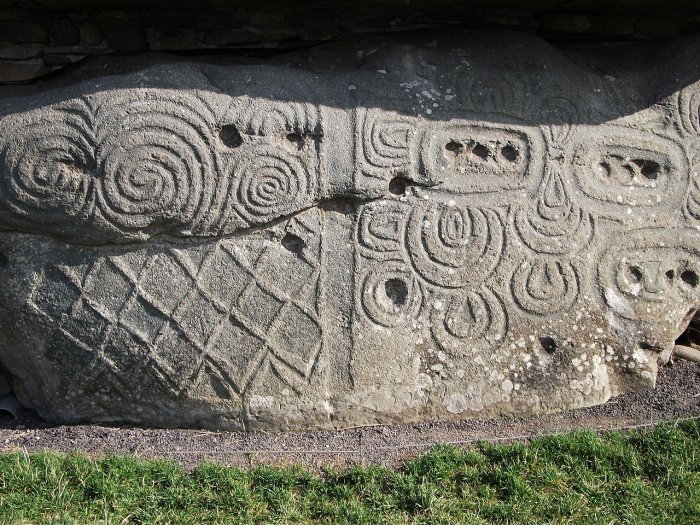
Stone at Newgrange - Megalithic art on one of the kerbstones - Image credit: Johnbod - - CC BY-SA 3.0
The gigantic Neolithic tomb of Newgrange (in Irish: Si An Bhru) is one of the world's most impressive prehistoric monuments, probably constructed about 5,100 years ago. The structure is older than the Great Pyramid of Giza and the Stonehenge enormous trilithons.
First written references to Newgrange appear as early as 656 AD in medieval Irish annals, and during the Roman times, Newgrange was already a ruin.
It is believed that the ancient Celts considered the place as an abode of spirits and a former home of their mythological ancestors, "the peoples of the goddess Danu" (Tuatha Dé Danann). Danu was a mother goddess associated with Anu, another Celtic mother goddess who sponsored fertility and prosperity in the land. Some Celtic traditions say that Newgrange belonged to the Daghda ("the good god").
The Celts believed the abandoned prehistoric tombs, such as Newgrange, were portals ('sidh') to the mysterious and dangerous Otherworld, with its subterranean realms and hidden places within the hills.
View of Newgrange, archaeological site of Brú na Bóinne. Image credit: Jean Housen - CC BY-SA 3.0
Professor Michael J. O'Kelly excavated and restored the megalithic passage tomb at Newgrange from 1962 to 1975. He discovered that the builders of Newgrange deliberately oriented the passage so that each year around the winter solstice, the rising Sun's rays would shine through a unique aperture he called a roof box to illuminate the chamber.
Newgrange has a diameter of about 264 ft and is almost circular. Stones layered with turf form the Newgrange's mound, surrounded by 97 large stones, the so-called 'kerbstones' (curbstones), some of which are richly decorated.
Surrounding the Newgrange mound is a ring of 12 standing stones, up to 8 feet in height. There were probably approximately 35 upright stones, but they were destroyed or removed over time.
Newgrange is famous for a spectacular phenomenon occurring at the site every year for a few days around the 21st or 22nd of December. The entrance to the Newgrange passage tomb contains a doorway with two standing stones and a horizontal lintel.
A section of the passage leading towards the chamber of the Newgrange passage tomb in Ireland. Image credit: O'Dea - CC BY-SA 4.0
Above this doorway is the 'roof box' or 'lightbox.' Every year after 9 am (on the early morning of the winter solstice – the shortest day of the year) – the newly risen Sun sends a shaft of sunlight through the Newgrange' light box', creating a narrow beam of light illuminating the central chamber located at the back of the tomb.
The phenomenon lasts 17 minutes, the beam of light slowly disappears, and the chamber is dark again.
It is commonly agreed that the Iron Age Celts did not build Newgrange, but it was unclear how old it really was.
Finally, Professor O'Kelly excavated and restored Newgrange from 1962 to 1975. He discovered that those who built the Newgrange deliberately oriented the passage so that each year around midwinter, the rising Sun's rays would shine through a unique aperture to illuminate the chamber.
Sketch of a cross section of the Newgrange passage grave made by William Frederick Wakeman (d. 1900). Screen capture of PDF version of the 1903 edition converted into black and white and adjusted for contrast and brightness. William Frederick Wakeman - Wakeman's handbook of Irish antiquities (1903). p. 85. - Public Domain
The stone chamber and mound at Newgrange in Ireland has a 'lightbox' allowing the sunrise to be glimpsed briefly on a midwinter day.
According to radiocarbon dating conducted by O'Kelly, Newgrange was constructed in the last centuries of the fourth millennium BC, probably around 3200 BC.
The Newgrange monument's primary functions as a tomb, an astronomical observatory, or an ancient temple celebrating the Sun's union with Mother Earth are often disputed.
Written by – A. Sutherland AncientPages.com Staff Writer
Updated on December 19, 2022
Copyright © AncientPages.com All rights reserved. This material may not be published, broadcast, rewritten or redistributed in whole or part without the express written permission of AncientPages.com
Expand for referencesMore From Ancient Pages
-
 Roman Leather Toy Mouse Found At Vindolanda
Archaeology | Jun 6, 2023
Roman Leather Toy Mouse Found At Vindolanda
Archaeology | Jun 6, 2023 -
 Mystery Of Dakhamunzu And The Zannanza Affair – Was Queen Ankhesenamun Hiding Her Identity?
Featured Stories | Feb 1, 2019
Mystery Of Dakhamunzu And The Zannanza Affair – Was Queen Ankhesenamun Hiding Her Identity?
Featured Stories | Feb 1, 2019 -
 Sumerian Clay Brick With Inscription In Honor Of God Enki Returns To Iraq
Archaeology | May 5, 2015
Sumerian Clay Brick With Inscription In Honor Of God Enki Returns To Iraq
Archaeology | May 5, 2015 -
 Teotihuacán: Enigmatic Birthplace Of The Gods And Its Obscure History
Civilizations | Jul 26, 2016
Teotihuacán: Enigmatic Birthplace Of The Gods And Its Obscure History
Civilizations | Jul 26, 2016 -
 Giant 7,000-Year-Old Astronomical Calendar Discovered In Poland?
Archaeology | Dec 22, 2017
Giant 7,000-Year-Old Astronomical Calendar Discovered In Poland?
Archaeology | Dec 22, 2017 -
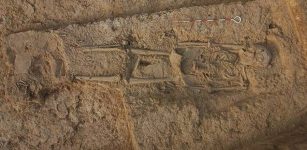 Early Harappan Burial Site With 26 Graves Unearthed In Kutch, Western India
Archaeology | Mar 14, 2019
Early Harappan Burial Site With 26 Graves Unearthed In Kutch, Western India
Archaeology | Mar 14, 2019 -
 What Happened To The Staircase In The Temple Of The Goddess Hathor?
Civilizations | Mar 9, 2017
What Happened To The Staircase In The Temple Of The Goddess Hathor?
Civilizations | Mar 9, 2017 -
 Rare Early Bronze Age Axe Discovered In Slovakia
Archaeology | Jul 2, 2022
Rare Early Bronze Age Axe Discovered In Slovakia
Archaeology | Jul 2, 2022 -
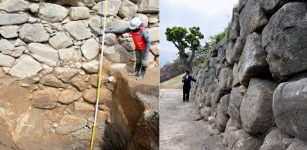 Excavations At Okazaki Castle Reveal A 400-Year-Old Massive Unbroken Wall
Archaeology | Apr 16, 2016
Excavations At Okazaki Castle Reveal A 400-Year-Old Massive Unbroken Wall
Archaeology | Apr 16, 2016 -
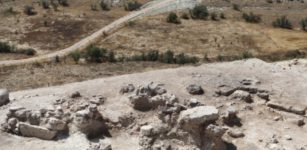 A 3,500-Year-Old Grape Seed Sheds Light On Great Tradition Of Vineyards Of Anatolia’s Çal And Region
Archaeology | Sep 13, 2023
A 3,500-Year-Old Grape Seed Sheds Light On Great Tradition Of Vineyards Of Anatolia’s Çal And Region
Archaeology | Sep 13, 2023 -
 Ancient Tradition And True Meaning Of Candy Canes
Christmas Traditions | Dec 26, 2024
Ancient Tradition And True Meaning Of Candy Canes
Christmas Traditions | Dec 26, 2024 -
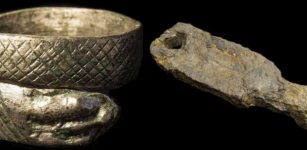 Discovery Of Roman Settlement, Workshops And Artifacts Will Shed Light On Their Life In Northern England
Archaeology | Apr 13, 2017
Discovery Of Roman Settlement, Workshops And Artifacts Will Shed Light On Their Life In Northern England
Archaeology | Apr 13, 2017 -
 Remarkable Neolithic Life-Sized Camel Engravings Discovered In The Nefud Desert
Archaeology | Oct 5, 2023
Remarkable Neolithic Life-Sized Camel Engravings Discovered In The Nefud Desert
Archaeology | Oct 5, 2023 -
 Baffling Sanxingdui Civilization: Why Did These People Have Fascination For Eyes?
Civilizations | Mar 21, 2017
Baffling Sanxingdui Civilization: Why Did These People Have Fascination For Eyes?
Civilizations | Mar 21, 2017 -
 Remarkable Le Catillon II Hoard – World’s Largest Collection Of Celtic Coins And Jewellery
Archaeology | Nov 24, 2015
Remarkable Le Catillon II Hoard – World’s Largest Collection Of Celtic Coins And Jewellery
Archaeology | Nov 24, 2015 -
 Zoroaster’s Doomsday Prophecy About Comet Gochihr And Its Similarity With The Apocalypse Of John In The Book Of Revelation
Biblical Mysteries | Aug 17, 2017
Zoroaster’s Doomsday Prophecy About Comet Gochihr And Its Similarity With The Apocalypse Of John In The Book Of Revelation
Biblical Mysteries | Aug 17, 2017 -
 Drought Was Not The Reason Cahokia, North America’s First City Was Suddenly Abandoned – New Study
Archaeology | Jul 4, 2024
Drought Was Not The Reason Cahokia, North America’s First City Was Suddenly Abandoned – New Study
Archaeology | Jul 4, 2024 -
 Is The Mystery Of Controversial Phaistos Disk Solved?
Archaeology | Dec 17, 2015
Is The Mystery Of Controversial Phaistos Disk Solved?
Archaeology | Dec 17, 2015 -
 Amaru (Katari) – Powerful Inca God Who Controlled Weather Phenomena
Featured Stories | Apr 9, 2024
Amaru (Katari) – Powerful Inca God Who Controlled Weather Phenomena
Featured Stories | Apr 9, 2024 -
 World’s Oldest Dala Horse Discovered In Sweden
Archaeology | Jul 18, 2020
World’s Oldest Dala Horse Discovered In Sweden
Archaeology | Jul 18, 2020



